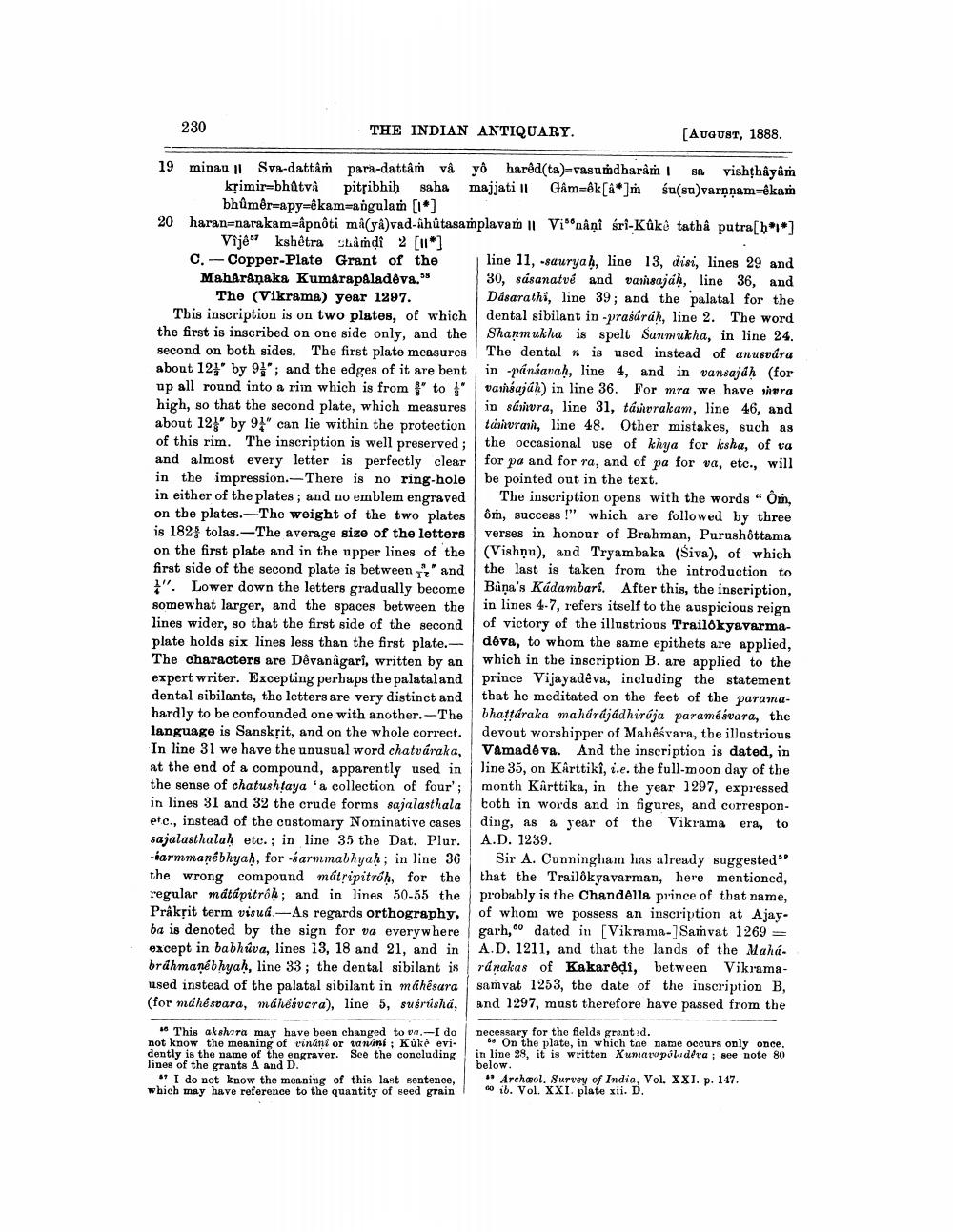________________
230
THE INDIAN ANTIQUARY.
[August, 1888.
19 minau 11 Sva-dattam para-dattâm và yê hared(ta)-vasundharam sa vishthâyám
krimir=bhatva pitribhih saha majjati | GÂm=ék[4*]ỉ su(su)varnnam-êkam
bhůmêr=apy-êkam=angulam [1] 20 haran-narakam=åpnôti mi(ya)vad-ihûtasamplava 1 Vi"nani sri-Kûků tatha putra[ho]
Vîje kshetra chåmdi 2 [11] C. - Copper-Plate Grant of the line 11, -sauryah, line 13, disi, lines 29 and Maharanaka Kumarapaladeva." 30, sasanatvé and varisajah, line 36, and The (Vikrama) year 1297.
Dásarathi, line 39; and the palatal for the This inscription is on two plates, of which dental sibilant in-prasúráh, line 2. The word the first is inscribed on one side only, and the Shanmukha is spelt Sanmukha, in line 24. second on both sides. The first plate measures The dental " is used instead of an usvara about 12} by 9}"; and the edges of it are bent in -pánsavah, line 4, and in vansajdh (for up all round into a rim which is from $' to " vamisajah) in line 36. For mra we have vura high, so that the second plate, which measures in sunwra, line 31, tárinurakam, line 46, and about 121 by 91" can lie within the protection túnirani, line 48. Other mistakes, such as of this rim. The inscription is well preserved; the occasional use of khya for ksha, of ta and almost every letter is perfectly clear for pa and for ra, and of pa for va, etc., will in the impression. There is no ring-hole be pointed out in the text. in either of the plates; and no emblem engraved The inscription opens with the words “ Om, on the plates.-The weight of the two plates Ôm, success!" which are followed by three is 182} tolas.-The average size of the letters verses in honour of Brahman, Purushottama on the first plate and in the upper lines of the (Vishņu), and Tryambaka (Siva), of which first side of the second plate is between it and the last is taken from the introduction to
". Lower down the letters gradually become Baņa's Kadambari. After this, the inscription, somewhat larger, and the spaces between the in lines 4-7, refers itself to the auspicious reign lines wider, so that the first side of the second of victory of the illustrious Trailokyavarmaplate holds six lines less than the first plate.- déva, to whom the same epithets are applied, The characters are Dêvanîgari, written by an which in the inscription B. are applied to the expert writer. Excepting perhaps the palataland prince Vijayadêva, including the statement dental sibilants, the letters are very distinct and that he meditated on the feet of the parama. hardly to be confounded one with another. The bhattáraka mahúrájádhirója paraméávara, the language is Sanskțit, and on the whole correct. devout worshipper of Mahêśvara, the illustrious In line 31 we have the unusual word chatváraka, Vamadeva. And the inscription is dated, in at the end of a compound, apparently used in line 35, on Karttiki, i.e. the full-moon day of the the sense of chatushtaya 'a collection of four'; month Karttika, in the year 1297, expressed in lines 31 and 32 the crude forms sajalasthala both in words and in figures, and corresponetc., instead of the customary Nominative cases ding, as a year of the Vikrama era, to sajalasthalah etc.; in line 35 the Dat. Plur. A.D. 1239. -harmmanébhyah, for-sarmmabhyah; in line 36 Sir A. Cunningham has already suggested the wrong compound matripitrón, for the that the Trailokyavarman, here mentioned, regular mátápitrôh; and in lines 50-55 the probably is the Chandella prince of that name, Prakrit term visul.- As regards orthography, of whom we possess an inscription at Ajayba is denoted by the sign for va everywhere garh, dated in [Vikrama-] Samvat 1269 = except in babhúva, lines 13, 18 and 21, and in A.D. 1211, and that the lands of the Maha brahman@bhyah, line 33; the dental sibilant is ránakas of Kakarédi, between Vikramaused instead of the palatal sibilant in méhésara samvat 1253, the date of the inscription B, (for máhêsvara, máhésucra), line 5, sugrúshá, and 1297, must therefore have passed from the
46 This akshara may have been changed to vn.-I do not know the meaning of rinani or va wini: Kuke evi. dently is the name of the engraver. See the concluding lines of the grants A and D.
" I do not know the meaning of this last sentence, which may have reference to the quantity of seed krain
necessary for the fields grant:d.
06 On the plato, in which toe name occurs only once. in line 29, it is writton Kumaru pólidera; see note 80 below. * Archæol. Survey of India, Vol. XXI. p. 147. i b. Vol. XXI. plate xii. D.
to the quantity last centence,
Are




